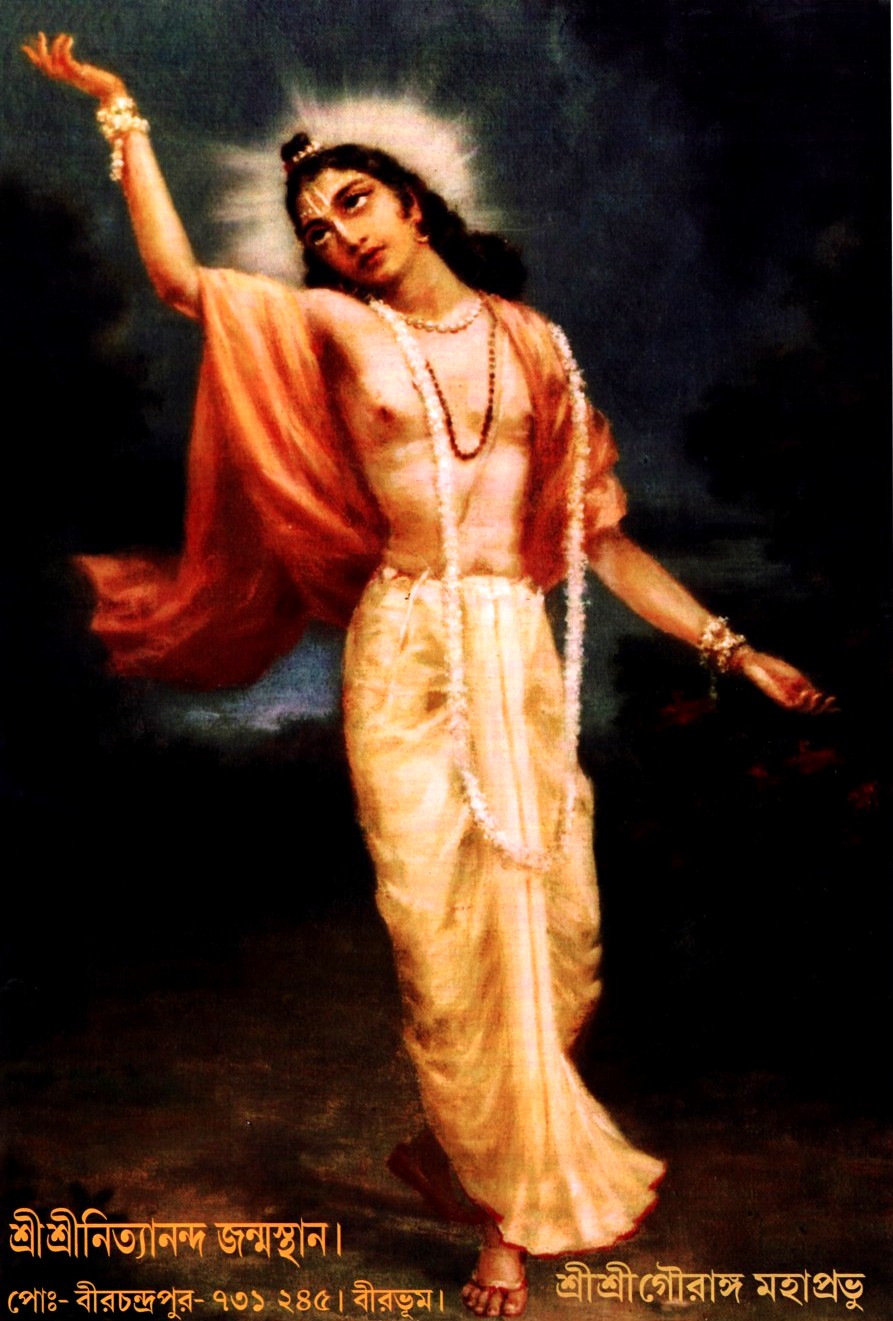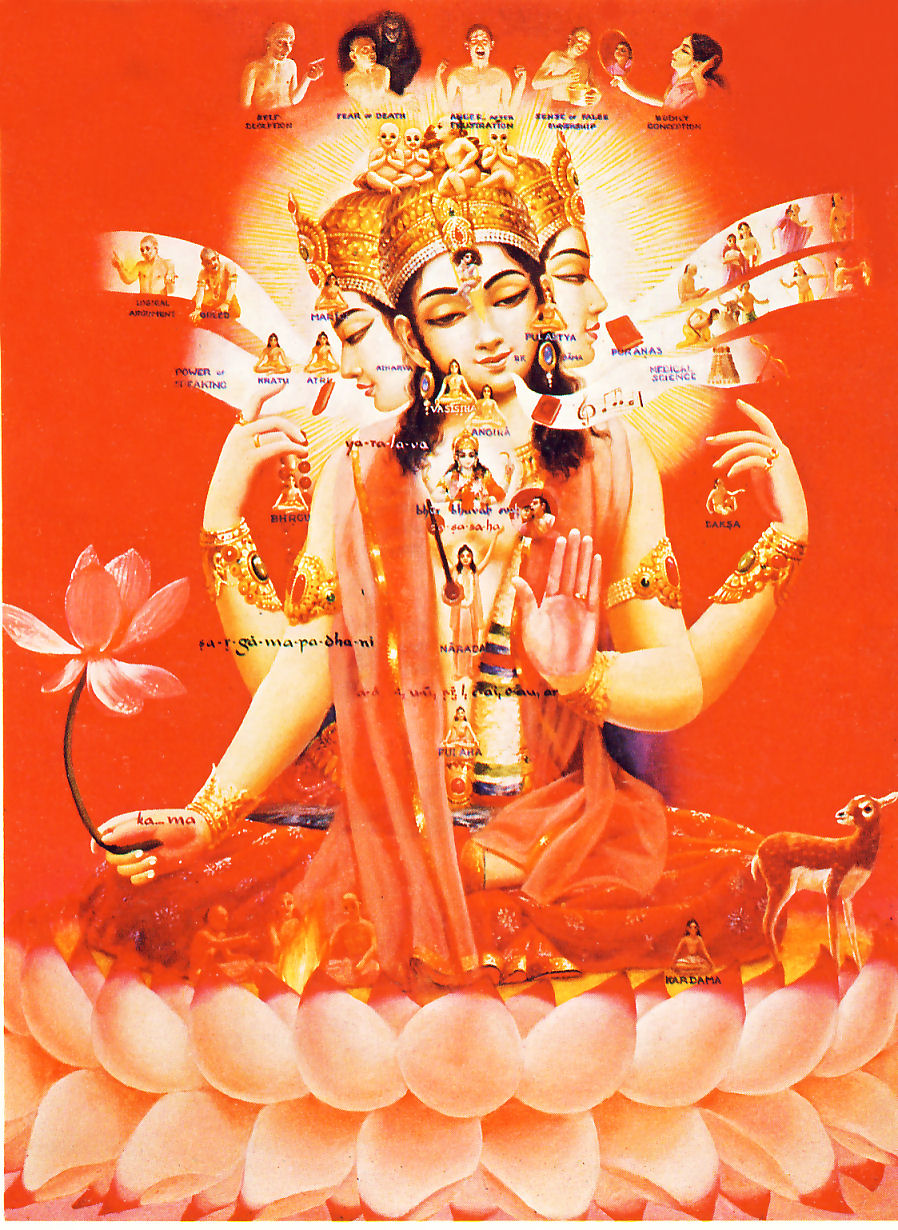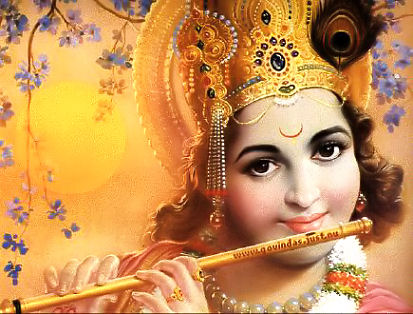Śrī Brahma-Saṁhitā
The Brahma-Saṁhitā is the hymn sung by Brahma, the first living being and creator of the universe, to worship his Lord, Shri Krishna. Lord Brahma was born on the lotus that grew from the navel of Shri Vishnu.
From the navel of Garbhodakashayi Vishnu sprouts a golden lotus flower that shines as brightly as a thousand suns. This lotus flower is the receptacle of all conditioned souls and the first living being to be born from this lotus flower was the 4-headed Brahma. Sometimes when there is a scarcity of living beings qualified for the post of Brahma, Visnu expands himself as Brahma. When Brahma, the first spiritual master of this universe, could not locate the origin of the lotus flower, he was puzzled as to how to create the material world. As he was pondering, he suddenly heard two syllables sound out of nowhere: ta-pa (renunciation). He immediately searched for the source of these syllables, but finding nothing, he thought it wise to sit down on his lotus flower and – as instructed – practice renunciation. He did this for 1000 years of the demigods and is therefore known as the greatest ascetic. Another name of Brahma is Svayambhu (he who was born without mother and father). As Visnu was very pleased with his renunciation, He revealed Himself, as well as His transcendental realm – Vaikhuntaloka – to Brahma. Thereupon Brahma was overwhelmed with joy, his eyes filled with tears and he bowed down before his Lord. Seeing Brahma like this, Vishnu considered him worthy of creating living beings and granted him every boon. Brahma then worshipped his Lord with the following hymn:
Lord Brahmas prayers to Lord Krishna
– Brahma-samhita –
īśvaraḥ paramaḥ kṛṣṇaḥ
sac-cid-ānanda-vigrahaḥ
anādir ādir govindaḥ
sarva-kāraṇa-kāraṇam
“Krsna who is known as Govinda is the Supreme Godhead. He has an eternal blissful spiritual body. He is the origin of all. He has no other origin and He is the prime cause of all causes.” (Brahma-samhita 5.1)
cintāmaṇi-prakara-sadmasu kalpa-vṛkṣa-
lakṣāvṛteṣu surabhir abhipālayantam
lakṣmī-sahasra-śata-sambhrama-sevyamānaṁ
govindam ādi-puruṣaṁ tam ahaṁ bhajāmi
” I worship Govinda, the primeval Lord, the first progenitor who is tending the cows, yielding all desire, in abodes built with spiritual gems, surrounded by millions of purpose trees, always served with great reverence and affection by hundreds of thousands of lakshmis or gopis.” (Brahma-samhita 5.29)
veṇuṁ kvaṇantam aravinda-dalāyatākṣaṁ
barhāvataṁsam asitāmbuda-sundarāṅgam
kandarpa-koṭi-kamanīya-viśeṣa-śobhaṁ
govindam ādi-puruṣaṁ tam ahaṁ bhajāmi
“I worship Govinda, the primeval Lord, who is adept in playing on His flute, with blooming eyes like lotus petals with head decked with peacock’s feather, with the figure of beauty tinged with the hue of blue clouds, and His unique loveliness charming millions of Cupids.” (Brahma Sanghita 5.30)
ālola-candraka-lasad-vanamālya-vaṁśī-
ratnāṅgadaṁ praṇaya-keli-kalā-vilāsam
śyāmaṁ tri-bhaṅga-lalitaṁ niyata-prakāśaṁ
govindam ādi-puruṣaṁ tam ahaṁ bhajāmi
“I worship Govinda, the primeval Lord, round whose neck is swinging a garland of flowers beautified with the moon-locket, whose two hands are adorned with the flute and jeweled ornaments, who always revels in pastimes of love, whose graceful threefold-bending form of Syamasundara is eternally manifest.” (Brahma-samhita 5.31)
aṅgāni yasya sakalendriya-vṛtti-manti
paśyanti pānti kalayanti ciraṁ jaganti
ānanda-cinmaya-sad-ujjvala-vigrahasya
govindam ādi-puruṣaṁ tam ahaṁ bhajāmi
“I worship Govinda, the primeval Lord, whose transcendental form is full of bliss, truth, substantiality and is thus full of the most dazzling splendor. Each of the limbs of that transcendental figure possesses in Himself, the full-fledged functions of all the organs, and eternally sees, maintains and manifests the infinite universes, both spiritual and mundane.” (Brahma-samhita 5.32)
advaitam acyutam anādim ananta-rūpam
ādyaṁ purāṇa-puruṣaṁ nava-yauvanaṁ ca
vedeṣu durlabham adurlabham ātma-bhaktau
govindam ādi-puruṣaṁ tam ahaṁ bhajāmi
“I worship Govinda, the primeval Lord, who is inaccessible to the Vedas, but obtainable by pure unalloyed devotion of the soul, who is without a second, who is not subject to decay, is without a beginning, whose form is endless, who is the beginning, and the eternal puruṣa; yet He is a person possessing the beauty of blooming youth.” (Brahma-samhita, 5.33)
ānanda-cinmaya-rasa-pratibhāvitābhis
tābhir ya eva nija-rūpatayā kalābhiḥ
goloka eva nivasaty akhilātma-bhūto
govindam ādi-puruṣaṁ tam ahaṁ bhajāmi
“I worship Govinda, the primeval Lord, residing in His own realm, Goloka, with Rādhā, resembling His own spiritual figure, the embodiment of the ecstatic potency possessed of the sixty-four artistic activities, in the company of Her confidantes [sakhīs], embodiments of the extensions of Her bodily form, permeated and vitalized by His ever-blissful spiritual rasa.” (Brahma-samhita, 5.37)
premāñjana-cchurita-bhakti-vilocanena
santaḥ sadaiva hṛdayeṣu vilokayanti
yaṁ śyāmasundaram acintya-guṇa-svarūpaṁ
govindam ādi-puruṣaṁ tam ahaṁ bhajāmi
“I worship Govinda, the primeval Lord, who is Śyāmasundara, Kṛṣṇa Himself with inconceivable innumerable attributes, whom the pure devotees see in their heart of hearts with the eye of devotion tinged with the salve of love.” (Brahma-samhita, 5.38)
rāmādi-mūrtiṣu kalā-niyamena tiṣṭhan
nānāvatāram akarod bhuvaneṣu kintu
kṛṣṇaḥ svayaṁ samabhavat paramaḥ pumān yo
govindam ādi-puruṣaṁ tam ahaṁ bhajāmi
“I worship Govinda, the primeval Lord, who manifested Himself personally as Kṛṣṇa and the different avatāras in the world in the forms of Rāma, Nṛsiṁha, Vāmana, etc., as His subjective portions.” (Brahma-samhita, 5.39)
yasya prabhā prabhavato jagad-aṇḍa-koṭi-
koṭiṣv aśeṣa-vasudhādi vibhūti-bhinnam
tad brahma niṣkalam anantam aśeṣa-bhūtaṁ
govindam ādi-puruṣaṁ tam ahaṁ bhajāmi
“I worship Govinda, the primeval Lord, whose effulgence is the source of the nondifferentiated Brahman mentioned in the Upaniṣads, being differentiated from the infinity of glories of the mundane universe appears as the indivisible, infinite, limitless, truth.” (Brahma-samhita, 5.40)
dīpārcir eva hi daśāntaram abhyupetya
dīpāyate vivṛta-hetu-samāna-dharmā
yas tādṛg eva hi ca viṣṇutayā vibhāti
govindam ādi-puruṣaṁ tam ahaṁ bhajāmi
“The light of one candle being communicated to other candles, although it burns separately in them, is the same in its quality. I adore the primeval Lord Govinda who exhibits Himself equally in the same mobile manner in His various manifestations.” (Brahma-Samhita 5,46)
yaḥ kāraṇārṇava-jale bhajati sma yoga-
nidrām ananta-jagad-aṇḍa-sa-roma-kūpaḥ
ādhāra-śaktim avalambya parāṁ sva-mūrtiṁ
govindam ādi-puruṣaṁ tam ahaṁ bhajāmi
“I adore the primeval Lord Govinda who assuming His own great subjective form, who bears the name of Śeṣa, replete with the all-accommodating potency, and reposing in the Causal Ocean with the infinity of the world in the pores of His hair, enjoys creative sleep [yoga-nidrā].” (Brahma-samhita 5.47)
yac-cakṣur eṣa savitā sakala-grahāṇāṁ
rājā samasta-sura-mūrtir aśeṣa-tejāḥ
yasyājñayā bhramati sambhṛta-kāla-cakro
govindam ādi-puruṣaṁ tam ahaṁ bhajāmi
“The sun who is the king of all the planets, full of infinite effulgence, the image of the good soul, is as the eye of this world. I adore the primeval Lord Govinda in pursuance of whose order the sun performs his journey mounting the wheel of time.” (Brahma-samhita, 5.52)
yas tv indragopam athavendram aho sva-karma-
bandhānurūpa-phala-bhājanam ātanoti
karmāṇi nirdahati kintu ca bhakti-bhājāṁ
govindam ādi-puruṣaṁ tam ahaṁ bhajāmi
“I adore the primeval Lord Govinda, who burns up to their roots all fruitive activities of those who are imbued with devotion and impartially ordains for each the due enjoyment of the fruits of one’s activities, of all those who walk in the path of work, in accordance with the chain of their previously performed works, no less in the case of the tiny insect that bears the name of indragopa than in that of Indra, king of the devas.” (Brahma-Samhita 5,54)
śriyaḥ kāntāḥ kāntaḥ parama-puruṣaḥ kalpa-taravo
drumā bhūmiś cintāmaṇi-gaṇa-mayī toyam amṛtam
kathā gānaṁ nāṭyaṁ gamanam api vaṁśī priya-sakhī
cid-ānandaṁ jyotiḥ param api tad āsvādyam api ca
sa yatra kṣīrābdhiḥ sravati surabhībhyaś ca su-mahān
nimeṣārdhākhyo vā vrajati na hi yatrāpi samayaḥ
bhaje śvetadvīpaṁ tam aham iha golokam iti yaṁ
vidantas te santaḥ kṣiti-virala-cārāḥ katipaye
“I worship that transcendental seat, known as Śvetadvīpa where as loving consorts the Lakṣmīs in their unalloyed spiritual essence practice the amorous service of the Supreme Lord Kṛṣṇa as their only lover; where every tree is a transcendental purpose tree; where the soil is the purpose gem, all water is nectar, every word is a song, every gait is a dance, the flute is the favorite attendant, effulgence is full of transcendental bliss and the supreme spiritual entities are all enjoyable and tasty, where numberless milk cows always emit transcendental oceans of milk; where there is eternal existence of transcendental time, who is ever present and without past or future and hence is not subject to the quality of passing away even for the space of half a moment. That realm is known as Goloka only to a very few self-realized souls in this world.” (Brahma Samhita 5.56)
Download complete version with Sanskrit and Roman Transliteration
The Brahma-samhita is the hymn sung by Brahma, the creator of the universe, to worship his Lord, Shri Krishna.
Lord Brahma, who was born on the lotus that grew from the navel of Shri Vishnu, received initiation from Shri Krishna at the beginning of cosmic times after a long period of meditation. He is also the first representative of the disciplic succession of the Hare Krishna movement. In the Brahma-samhita, Brahma presents all the essential conclusions of this disciplic succession and conveys his vision of spiritual reality.
Part of this hymn was discovered at the beginning of the 17th century. The following incident is reported:
Shri Chaitanya, Krishna in His golden form as a devotee, went on pilgrimage through South India from about 1510 to 1512 AD to spread love of God. From Puri He wandered south, where He visited holy places like Shri Ranga-kshetra, Setubandha, Rameshvara and finally Kanyakumari (Cape Comorin). He then turned north, traveling along the banks of the river Payashvini, which is in the Travancore state, and then reached the temple of Adi-Keshava in the Trivandrum area.
Shri Chaitanya’s most important biographer, Krishnadasa Kaviraja Gosvami, reports that when Chaitanya saw the image of Adi-Keshava (Krishna) in the temple, He was overwhelmed with spiritual ecstasy, offered heart-rending prayers and sang and danced with emotion – a marvelous sight that was received with astonishment and joy by the devotees there.
After Shri Chaitanya had discussed esoteric spiritual topics with some highly advanced devotees, He discovered the fifth chapter of the Brahma-samhita. This one chapter is known today as the Brahma-samhita, although the entire work consists of 100 chapters. 99 chapters are unknown to mankind today.

When Shri Chaitanya discovered the manuscript, He felt deep ecstasy and went into an intense mystical trance, which manifested itself outwardly through torrents of tears, trembling and sweating.
Shri Chaitanya declared the Brahma-samhita to be the most precious jewel and commissioned a scribe to copy the manuscript so that it could be distributed.
In the course of time, the Brahma-samhita spread and became one of the main texts of Gaudiya Vaishnava scripture. “There is no scripture equal to the Brahma-samhita in terms of ultimate spiritual conclusion,” enthused Krishnada’s Kaviraja Gosvami. “Indeed, this scripture is the highest revelation of the glories of Govinda, for it reveals the highest knowledge of Him. Since all conclusions are briefly presented in the Brahma-samhita, it is the essence of all Vaishnava literature.” (Chaitanya-charitamrita, Madhya-lila 9.239 – 240)
The complete whole Brahma-samhita as pdf is accesible through this link:
here the complete enlgish version
Here is some more information about the verses. Verses 5.30 and 5.32 were set to music by George Harrison in the song “Govinda prayers“, which ranked very high in the music charts at the time. This song is played in the morning in the Hare Krishna temples. You can listen to this song “Radha Krishna Temple” here and download it free of charge.
Purport on Brahma-samhita by Shrila Bhaktisiddhanta Sarasvati Thakura:
“For lack of taste for spiritual things, a grave doubt arises in the minds of those who have chained themselves to worldly knowledge.
 When they hear the description of Krishna’s pastimes, they believe that the truth about Krishna is the figment of the imagination of certain learned scholars who have created it with the help of their imagination from material derived from worldly principles. With the aim of removing this harmful doubt, Brahma, in this and the following three verses, after rationally distinguishing between the two matters, namely spiritual and material, tries to convey the understanding of the pure play of Krishna, which was accessible to him through his unmixed ecstatic trance. Brahma wants to say that the form of Krishna is all-existence, all-knowledge and all-bliss, whereas all worldly experiences are full of conspicuous ignorance. And although there is a clear distinction between the two, the fundamental truth cannot be overlooked that spiritual matters are the absolute origin. Specificity and diversity are ever-present in it. They characterize the transcendental kingdom, the form, the name, the quality and the pastimes of Krishna. Only through a person who possesses pure spiritual knowledge and is free from any relationship with maya can these sweet pastimes of Krishna be even remotely appreciated.”
When they hear the description of Krishna’s pastimes, they believe that the truth about Krishna is the figment of the imagination of certain learned scholars who have created it with the help of their imagination from material derived from worldly principles. With the aim of removing this harmful doubt, Brahma, in this and the following three verses, after rationally distinguishing between the two matters, namely spiritual and material, tries to convey the understanding of the pure play of Krishna, which was accessible to him through his unmixed ecstatic trance. Brahma wants to say that the form of Krishna is all-existence, all-knowledge and all-bliss, whereas all worldly experiences are full of conspicuous ignorance. And although there is a clear distinction between the two, the fundamental truth cannot be overlooked that spiritual matters are the absolute origin. Specificity and diversity are ever-present in it. They characterize the transcendental kingdom, the form, the name, the quality and the pastimes of Krishna. Only through a person who possesses pure spiritual knowledge and is free from any relationship with maya can these sweet pastimes of Krishna be even remotely appreciated.”
 “The matchless beauty of Krishna, the Supreme Lord of Goloka, is being described. Krishna, the all-pervading cognition, has a spiritual form of His own. The form of Krishna is not a fanciful creation of imagination formed after visualizing the beautiful things of the world. What Brahmä saw in his ecstatic trance of pure devotion, is being described. Krishna is engaged in playing upon His flute. That flute by his enchanting musical sound attracts the hearts of all living beings. Just as a lotus petal produces a pleasant sight, so the two beautiful eyes of Krishna who causes the manifestation of our spiritual vision, display the unlimited splendor and beauty of His moonlike face. The loveliness that adorns His head with peacock feather figures, the corresponding feature of the spiritual beauty of Krishna. Just as a mass of blue clouds offers a specifically soothing, pleasant view, the complexion of Krishna is analogously tinged with a spiritual dark-blue color. The beauty and loveliness of Krishna is far more enchanting that that of Cupid multiplied a millionfold. ” (Brahma-samhita 5.30)
“The matchless beauty of Krishna, the Supreme Lord of Goloka, is being described. Krishna, the all-pervading cognition, has a spiritual form of His own. The form of Krishna is not a fanciful creation of imagination formed after visualizing the beautiful things of the world. What Brahmä saw in his ecstatic trance of pure devotion, is being described. Krishna is engaged in playing upon His flute. That flute by his enchanting musical sound attracts the hearts of all living beings. Just as a lotus petal produces a pleasant sight, so the two beautiful eyes of Krishna who causes the manifestation of our spiritual vision, display the unlimited splendor and beauty of His moonlike face. The loveliness that adorns His head with peacock feather figures, the corresponding feature of the spiritual beauty of Krishna. Just as a mass of blue clouds offers a specifically soothing, pleasant view, the complexion of Krishna is analogously tinged with a spiritual dark-blue color. The beauty and loveliness of Krishna is far more enchanting that that of Cupid multiplied a millionfold. ” (Brahma-samhita 5.30)